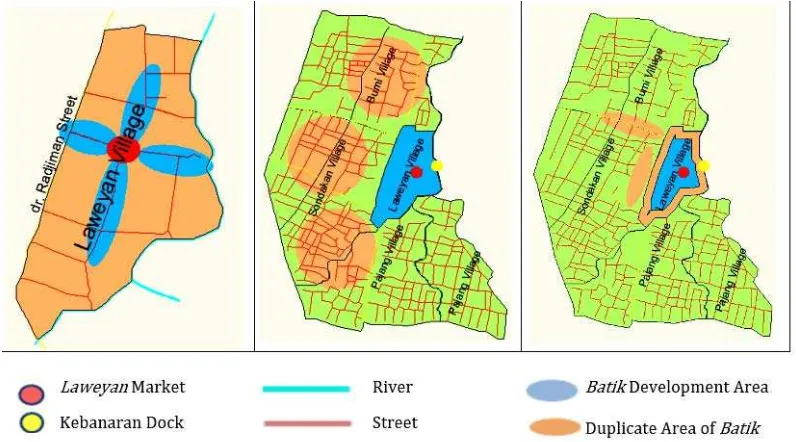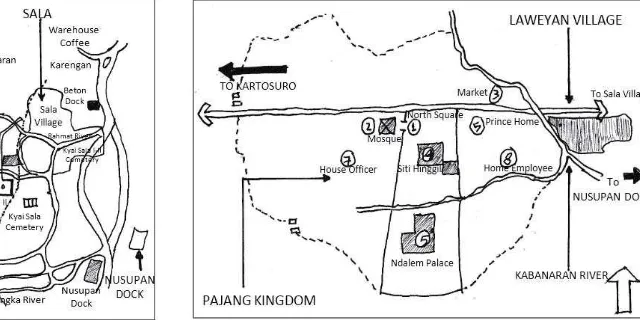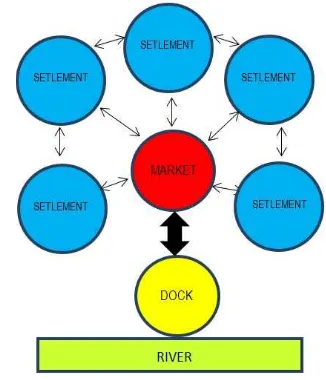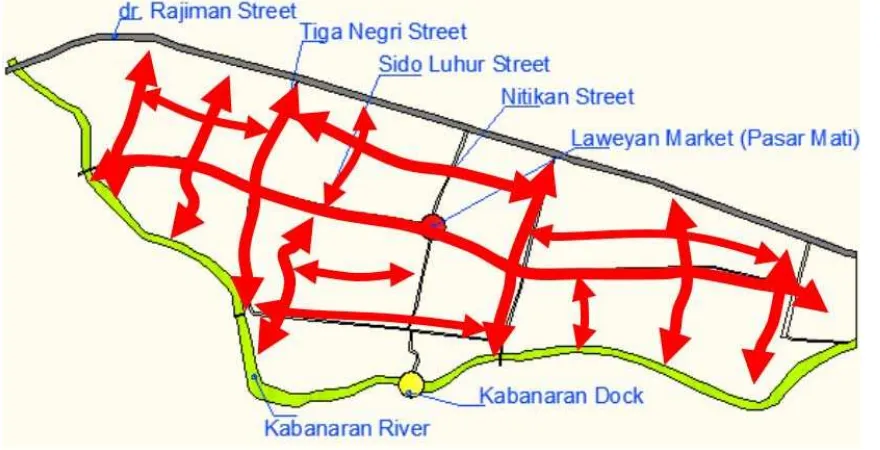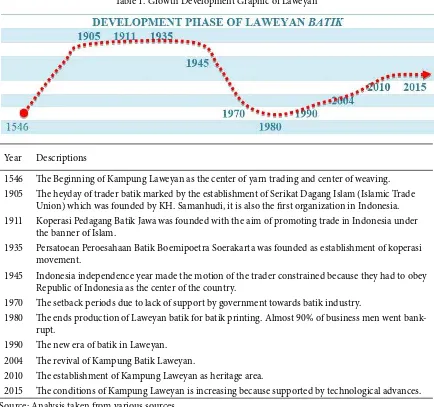IJG Vol. 48 No.1, June 2016 (85 - 90) © 2016 Faculty of Geography UGM and he Indonesian Geographers Association
Spatial Settlement Pattern in Laweyan as Supportive Batik
Produc-tion Activities
Rinaldi Mirsa, Sugiono Soetomo, Mussadun and Asnawi
Received: 24 10 2015 / Accepted: 15 01 2016 / Published online: 30 06 2016 © 2016 Faculty of Geography UGM and he Indonesian Geographers Association
Abstract Laweyan, a traditional village, has existed before 1500 AD. As the trade center yarn (clothing material) of Pa-jang Kingdom, its presence meant ater Kyai Ageng Anis (descendant of Brawijaya V) and grandson Raden Ngabehi Lor Ing Pasar who later became the irst king of Mataram settled in Laweyan in 1546. Laweyan entrepreneurship in the com-munities ushered in the heyday of batik economic in century. Successfulness in the ield of economy turned an impact on development in various ields, helped shape the pattern of space and environment. Spatial pattern and traditional settlements are usually much characterized by the mass of buildings that have appeared in the form of walls covered choke and surrounded by alley or narrow street, as seen in Laweyan with the existence of high ‘beteng’ which raises many narrow alleys and a Laweyan hallmark not only as a security but also one of the merchants attempt to maintain the privacy and obtain local authority in the community.
Abstrak Laweyan merupakan kampung tradisional yang keberadaannya sudah ada sejak sebelum tahun 1500 M. Sebagai
pusat perdagangan lawe (bahan sandang) kerajaan Pajang, kehadirannya baru berarti setelah Kyai Ageng Anis (keturunan Brawijaya V) dan cucunya yaitu Raden Ngabehi Lor Ing Pasar yang kelak menjadi raja pertama Mataram bermukim di Laweyan tahun 1546 M. Jiwa enterpreneurship yang dimiliki masyarakat Laweyan telah mengantar pada masa kejayaan ekonomi batik dalam abad tersebut. Kesuksesan dalam bidang ekonomi ternyata memberikan dampak terhadap perkem-bangan di berbagai bidang, hal ini ikut membentuk pola ruang dan lingkungannya. Pola ruang dan permukiman tradision-al biasanya banyak dicirikan dengan munculnya massa bangunan yang mempunyai tampak berupa dinding-dinding tertu-tup menghimpit dan dikelilingi oleh gang atau jalan sempit, hal ini terlihat di Laweyan dengan keberadaan “beteng” tinggi yang banyak memunculkan gang-gang sempit dan merupakan ciri khas Laweyan selain untuk keamanan juga merupakan salah satu usaha para saudagar untuk menjaga privacy dan memperoleh daerah kekuasaan di lingkungan komunitasnya.
Keywords: Space pattern, Batik production, Settlements
Kata kunci: Pola ruang, Produksi batik, Permukiman
1. Introduction
Kampung Laweyan grew in the midst of royal society bureaucrats and civilians. Sociologically, it can be said that Laweyan was enclave society [Soedarmono, 1987]. he existence of these communities were very diferent from the larger community around them, it made their existence and social interaction thus closed [Geertz, 1973]. he uniqueness of Kampung Laweyan in Surakarta (now known as Solo) with remnants of grand buildings, boutiques and batik industry which still exist, tells us a lot of things of history in the past [Priyatmono, 2004].
Although Laweyan society is not a descendant of nobility, they had a close relationship with the palace through batik trade and supported the existing wealth, settlement pattern especially belonging to the batik merchants was inluenced by the Javanese royal settlement patterns. Merchant house building usually
Rinaldi Mirsa
Depatment Of Architecture, Malikussaleh, Lhokseumawe, Aceh Province, Indonesia
Email: [email protected]
Sugiono Soetomo, Mussadun and Asnawi
Doctoral Program of Architecture and Urbanism Engineering, Diponogoro University, Indonesia
consists of Pendopo (hall), ndalem, sentong, gandok, pavilion, factory, beteng, regol, front yard which was quite extensive with the orientation of the building facing the North-South. Most of the building’s roof used limasan (a pyramid roof) instead joglo because they are not highborn [Widayati, 2002].
his is reinforced by the presence of batik production activities were embedded in Laweyan community settlements that have unique spatial patterns and supported these activities. he glorious era of batik trade began with the establishment of Serikat Dagang Islam (Islamic Trade Union), [Kartodirdjo, Sartono, 1993].
Discourse economic behavior of trade and batik industry in Solo was considered less worthy involved in the feudalistic kingdoms association. Most nobility royal lifestyle relected on feudal economic system, rather less pleased coexist with wong (society) Laweyan who relected their lifestyle as a entrepreneur considered selish, stingy, and were considered likely to show of wealth.
85 speciic spatial pattern as a result of batik activity itself (igure 1).
Building mass in the traditional settlement coincided one another, building fronts coincided with roads, buildings seem to resemble the walls. [Carmona et al., 2003]. According to Rowe and Kotter in Carmona, et al. [2003], “he mass of buildings in traditional or ancient city are usually related to each other to form the building blocks or urban block.”
Urban block separated from one another by grid-patterned streets and public spaces to form granules which are relatively small urban blocks.
Generally, in Laweyan there are 3 (three) clusters based on the large plot of each house in accordance with Persil home, namely: (a) parcels skipper batik with an average large size area of 1000 m² to 3000 m², (b) Persil home of skipper batik has medium size, an average area of 300 m² to 1000 m², (c) Persil home of batik workers with an average area of 50 m² to 300 m²
house is a living process for residents [Budiharjo, 1984], the house as the process develops in line with the psychological development of the occupants, social, and economic. House is also developed in accordance with the fulillment of the needs and growth. Stayed home is a fundamental needs for human being, home is a means of protection, providing tranquility of life and as a center for the development of the human personality, [Rapoport, A. 1969].
Kampung Laweyan as a traditional settlement, elements of the region formed by grain mass adjacent to each other to form a relatively narrow neighborhood street. Mass of buildings of the batik merchants is mostly composed of large and medium building mass. he buildings are usually equipped with a high fence that resembles ‘beteng’. he mass of a small building fewer in number and mostly belong batik workers. Figure 3 shows see the phase phasing agglomeration population in Laweyan.
2. he Methods
his study uses qualitative method with descriptive exploratory analysis. Data collection methods used in this study through observation and interviews (interview) as well as surveying institutional form of secondary data collection related to the study area. Sampling in this study is non-random sampling technique which aims sampling technique (purposive sampling). his technique is used due to the sample members speciically selected based on the purpose of research. For a sample of residential buildings is done by determining in advance the criteria batik production
houses region will be selected. hese data collection techniques include the following stages:
1) Observation and experience directly involved to see the phenomenon of space and activity. Active involvement allows various observations were made as well as experience as experienced by the public. his depend on the activities of the research unit determines above which all activities in the ield of activity and phenomena observed in detail.
87 3. Result and Discussion
A history of Laweyan area had begun since 1546, which existed through many royal periods simultaneously and inluenced by many kingdoms around Laweyan itself. he existence of Kampung Laweyan was started in 1546, continued exist in 3 royal areas: Kerajaan Pajang (1549 – 1587), Kerajaan Kartasura (1680 – 1742), and Kerajaan Surakarta (1755 – present) (Figure 4 and 5). In this era, Kampung Laweyan still continued exist especially in economics and batik crat. [Purwadi, 2007].
Besides the inluence of the kingdoms that grew around Laweyan, the other important element is batik production which is the main livelihood of Laweyan inhabitants as well as their economic boost in this area. Generally, the directions and orientation of the structure is facing the North – South like traditional Javanese settlements. For Cluster 1 area, the building is facing south while Cluster 2 and Cluster 3 area is facing north and the river.
A) For Cluster 1 area, he Building is facing south while cluster 2 and cluster 3 area is facing north and the river. It can be seen from the nodes which is serve generally as the center of orientation of the region, these
connects main Bandar called Bandar Nusupan which located in the outskirt of Bengawan Solo (Solo River).
his lane is also the main way of the batik economy and makes Bandar Kabanaran as a node which is very crowded and also the center orientation of the area. In addition, Bandar Kabanaran settled in the main line of transportation and trade from Kerajaan Pajang that connects with surrounding regions (Figure 7). here is a connection among Laweyan settlement, Laweyan market and Bandar Laweyan (Figure 8).
Based on the observation, the state and existence of Laweyan market with Bandar Kabanaran as the center of area as well as Kabanaran river as the main water transportation, can be proved with several ield observation, include:
a. Toponym region: he existence of name such as Kampung Lor Pasarmati and Kidul Pasarmati which indicates that once there is a market near that locations. In this case, Laweyan market is the center of the clothing trade.
b. Since ancient times, the road to the former market and Bandar in the riverbank was bigger than the surrounding road. It shown that the access to the market and Bandar are the main access to the area and
Figure 4. Kampung Laweyan position in Kerajaan
Pa-jang era in 1500. Figure 5. Map of Kampung Laweyan against the Kera-jaan Pajang.
Source : Museum Library Radya Farkhan and Junianto Surakarta, 2003
it means they have important roles as the center of area. c. he former Bandar area has widely open area with topographic slope which is diference than any other riverbanks. he widely open area and topographic slope helps people activities in Bandar easier especially for unloading the trade goods. Besides of that, close to the meeting of the road and the river, there is old Banyan tree which is the symbol of the region and placev for rest.
d. Kabanaran River at certain places still have many river channels which is wider and deeper and it prove that in the ancient times, Kabanaran river was suitable as the water transportations line.
Figure 7. Location of the former Bandar Kabanaran. Figure 6. Former location of Laweyan market.
Figure 8. he pattern area centered in Laweyan. Source: Analysis, 2014
Source: Analysis, 2014
89 others building. Indirectly, the circulation cause grid circulation pattern in Laweyan area (Figure 9). In the process of roads network establishment in this area, not only the main road formed but also the small alley among the buildings. In addition, the settlement areas of batik merchants is characterized by the shape of the mass of the building which is speciic as well as the dimensions of mass relatively larger and the settlement areas of labor is characterized by the shape of the mass which is simple and the dimensions of mass relatively small, thus forming cluster which is divided among skipper houses and the labors. As a result of the rapid growth that occurs an overall regional development. he development is inluenced by several events seen in certain years that the pattern can be seen in Table 1.
4. Conclusion
Based on the facts on the ield, the changing patterns in Laweyan area divided into several periods
Laweyan. Laweyan market transformation yarn market to batik market as well as the center shit of market which focus on Klewer maket is spreading to several others market. While Kabanaran River no longer serve as a transportation of trade, which had been replaced by highways and railways. While its function as an area for washing and drying batik is still done in the Kabanaran River area. In this period, the area pattern slowy changing because of shiting directions of circulation which leads to grid pattern.
3. Periods 1980, when the batik bussiness was over which motivated the inhabitants of Laweyan to look another opurtinity besides batik bussiness. It pushed them forward to make their own independent bussiness for each inhabitants which made population increase especially for labour. Because of that the riverbanks illed with many house of the labour with small pot of land about 100 – 300 m2, slowly change the area pattern in Laweyan to be cluster pattern.
References
Budihardjo, E. (1984). Sejumlah Masalah Permukiman
Kota. Bandung: Alumni.
Carmona et al (2003). Public Space Urban Space: he
Dimension of Urban Design. Architectural Press
London.
Geertz, C. (1973). Penjaja dan Raja. Jakarta: Badan
Penerbit Indonesia Raya.
Mlayadipuro (1984). Sejarah Kyai Ageng Anis-Kyai
Ageng Laweyan. Urip-Urip (penyunting: Santoso,
Suwito) Museum Radya Pustaka. Surakarta.
Priyatmono, A.F. (2004). Studi Kecenderungan
Perubahan Morfologi Kawasan di Kampung
Laweyan Surakarta. Program Pascasarjana
Universitas Gadjah Mada. Yogyakarta.
Priyatmono, A.F (2014). 50 Tahun Ketua Forum Pengembangan Kampung Batik Laweyan.
Wawancara Oktober 2014. Laweyan Solo.(in bahasa
Indonesia)
Purwadi (2007). Sejarah Raja-Raja Jawa. Yogyakarta: Media Ilmu.(in Bahasa Indonesia)
Rapoport, A. (1969). House Form and Culture, Prentice-Hall, Inc, Englewood Clifs, J. New York
Sajid, R. M. (1984). Babad Sala. Solo: Rekso Pustoko Perpustakaan Istana Mangkunegaran.
Soedarmono (1987). Munculnya Kelompok Pengusaha
Batik Di Laweyan Pada Awal Abad XX. Tesis.
(Yogyakarta: Fakultas Pasca Sarjana UGM).
Soedarmono (2006). Mbok Mase Pengusaha Batik di
Laweyan Solo Awal Abad 20. Yayasan Warna Warni
Indonesia.(in Bahas Indonesia)
Widayati, N (2002). Permukiman Pengusaha Batik Di
Laweyan Surakarta, Program Pascasarjana Fakultas Sastra Universitas Indonesia, Jakarta.
Year Descriptions
1546 he Beginning of Kampung Laweyan as the center of yarn trading and center of weaving.
1905 he heyday of trader batik marked by the establishment of Serikat Dagang Islam (Islamic Trade
Union) which was founded by KH. Samanhudi, it is also the irst organization in Indonesia.
1911 Koperasi Pedagang Batik Jawa was founded with the aim of promoting trade in Indonesia under
the banner of Islam.
1935 Persatoean Peroesahaan Batik Boemipoetra Soerakarta was founded as establishment of koperasi
movement.
1945 Indonesia independence year made the motion of the trader constrained because they had to obey
Republic of Indonesia as the center of the country.
1970 he setback periods due to lack of support by government towards batik industry.
1980 he ends production of Laweyan batik for batik printing. Almost 90% of business men went
bank-rupt.
1990 he new era of batik in Laweyan.
2004 he revival of Kampung Batik Laweyan.
2010 he establishment of Kampung Laweyan as heritage area.
2015 he conditions of Kampung Laweyan is increasing because supported by technological advances.
Table 1. Growth Development Graphic of Laweyan
